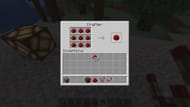The crafter is one of the coolest features of the Minecraft 1.21 update, also known as Tricky Trials. This block is a new redstone component that can input raw materials before crafting them into more complex and useful items automatically. These blocks are set to introduce automated crafting to the vanilla game, which will revolutionize a huge number of farms.
However, the crafter isn't as simple as it might appear at face value. Detailed below are 10 important pieces of information to keep in mind about the game's upcoming crafter block.
10 important things to know about Minecraft's upcoming crafter
1) Quite an expensive crafting recipe

Chart New Territories with the ultimate Minecraft Seed Generator!
Minecraft's upcoming crafters will undoubtedly be revolutionary. However, this comes at a price. Crafters are surprisingly expensive to make in large numbers, requiring five iron ingots, two redstone, a crafting table, and a dropper to create a single crafter. As a result, they will be prohibitively expensive early on, which makes sense due to their power.
2) Items are added in a particular order

Inputting items into a crafter will always add them in the same order. It starts at the top left, moving right until reaching the end of the row, before moving down and repeating. If a crafter is full, an item will be added to the smallest stack of similar items in the crafter.
3) Item byproducts

If a crafting recipe creates an item as a byproduct, such as how creating honey blocks with the honey bottles collected from a Minecraft bee farm will leave behind bottles, then the extra items will be ejected after the crafted one. This is important when setting up crafter farms, as these unintentional extra items might clog up unprepared hopper lines.
4) Interactable from every side

Hoppers and droppers can take items out of and place items into crafters from every side. This makes it possible to automate the crafting of very complex items since many different materials can be fed in simultaneously.
5) Crafters have a "face"

As previously mentioned, hoppers, droppers, and other similar blocks can interact with crafters from any side. However, it's important to note that there's only a single spot where crafters can output items. This is the "face" of the crafter and is represented by the small door that seems to open when items are ejected.
Items are spat out on this side of the block. However, if there is a storage block there, such as a chest or another Minecraft hopper chain, the item will instead be placed into its inventory.
6) Immovable objects

This crafter fact is Java Edition-specific. When it comes to Java pistons, crafters behave similarly to other block entities, such as chests. This means that Java players can't push crafters around using pistons the way Bedrock players can.
7) Spots can be locked

One of the most important things to keep in mind when it comes to Minecraft's crafters is that there's no need to fill up the entire crafting table every time it's used. Slots can be clicked within the crafter's UI to lock them, preventing hoppers or droppers from inserting items into those spots. This is what makes the shaped crafting needed for most items possible.
8) No QC

This is another Java-Edition-exclusive crafter fact. Java Edition redstone is famous for its quasiconnectivity. In fact, this is one of the most famous differences between Minecraft Bedrock and Java.
This is a bug-turned feature of redstone where some blocks, like pistons, dispensers, and droppers, can be powered by anything that would power the block above them. Crafters are lacking this incredibly handy feature, which is important to keep in mind when using them in builds.
9) Comparator visibile

Crafters can produce several different signals for Minecraft comparators. The single strength a comparator gets from a crafter is equal to the number of crafter slots that are either disabled or filled by an item. This means that crafters have a maximum redstone signal strength of nine.
10) Technically counts as storage

Interestingly enough, the crafter also counts as a storage block. Any item that can be placed into a crafting interface can be placed into a crafter. This doesn't make the block very useful as storage, but it might make for an okay hiding spot for a Minecraft multiplayer base.
Uncover new worlds with our Minecraft Seed Generator!
